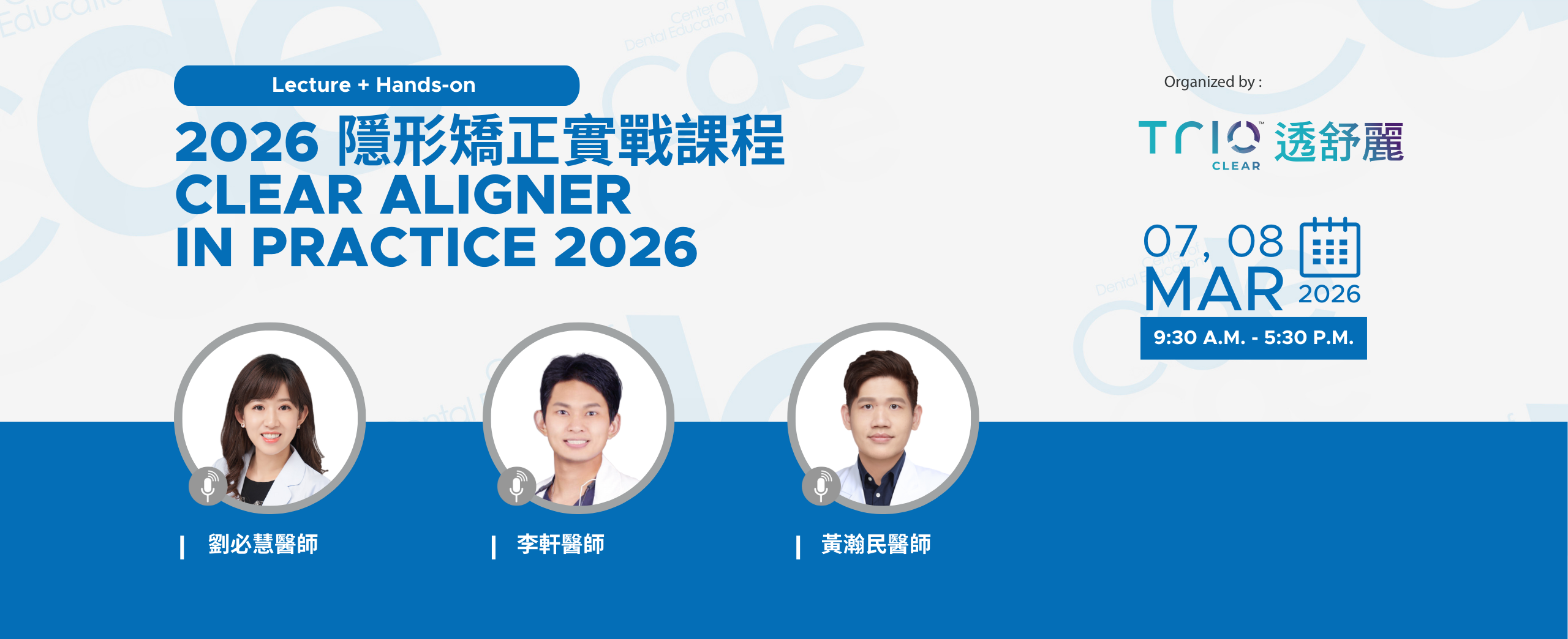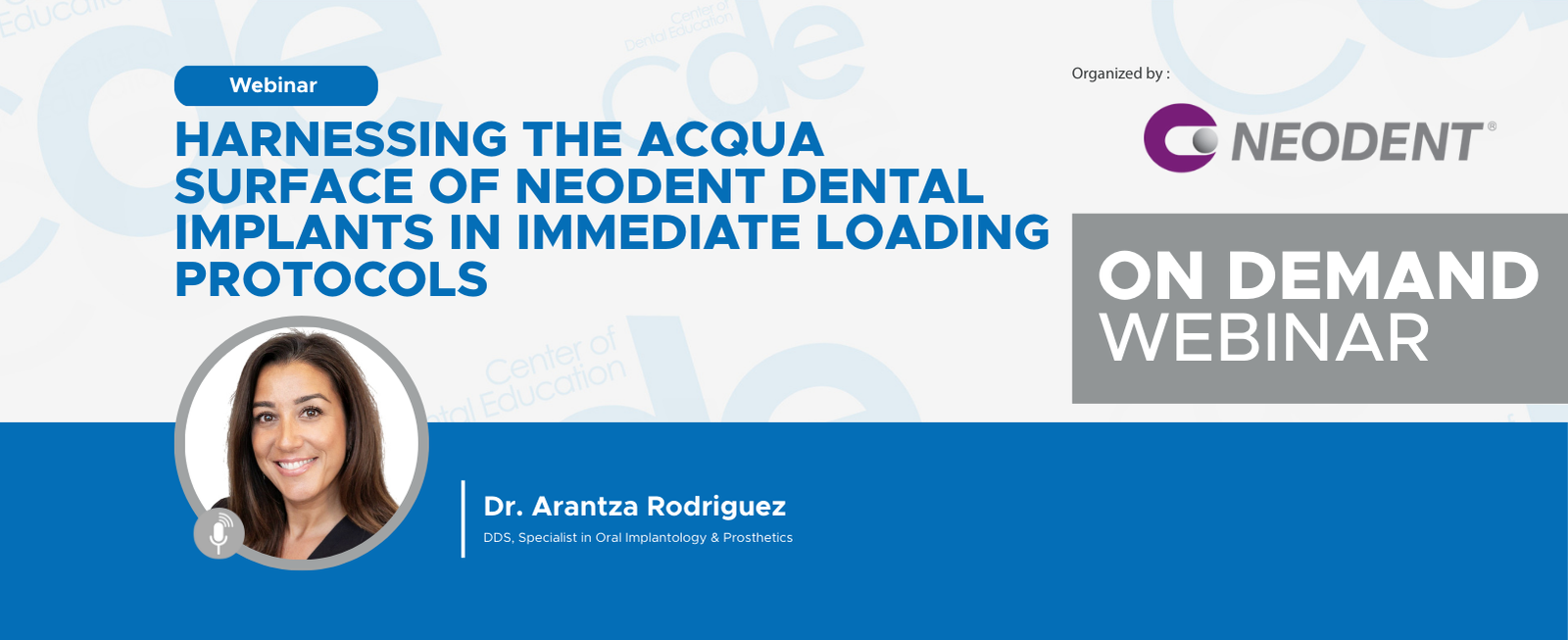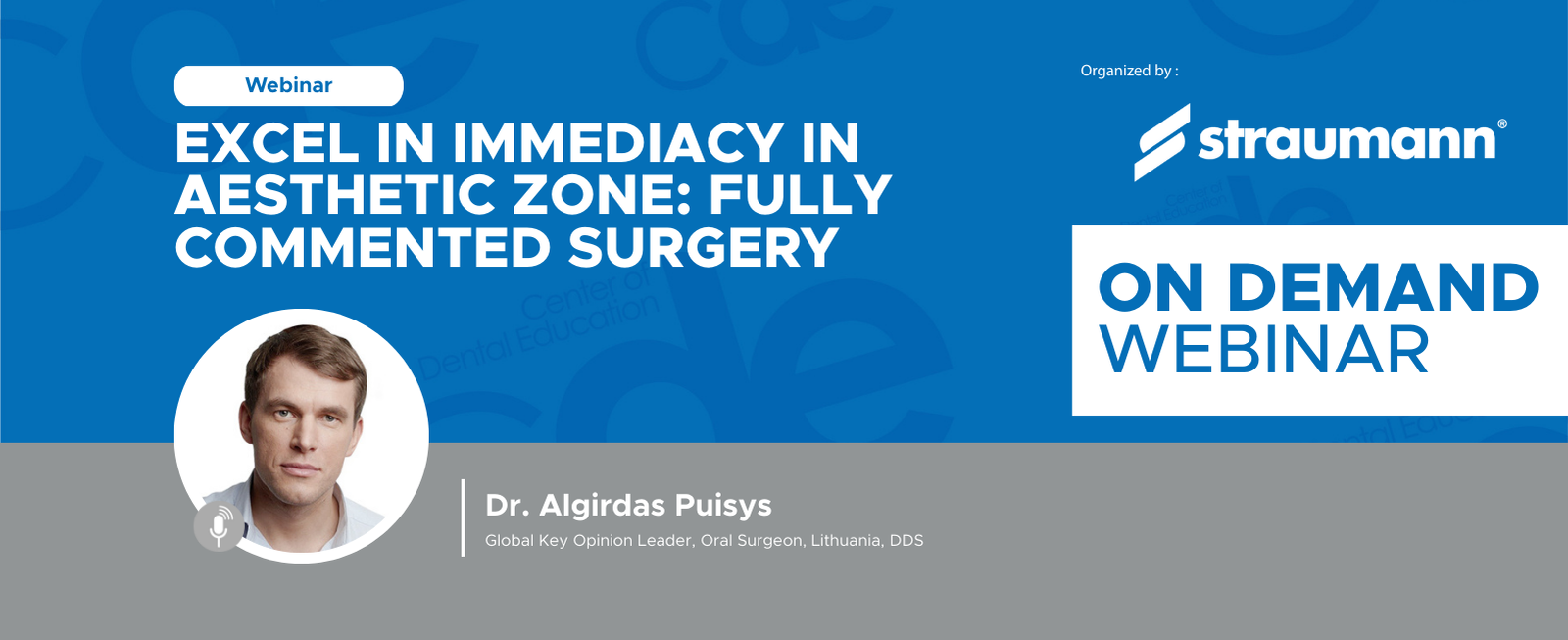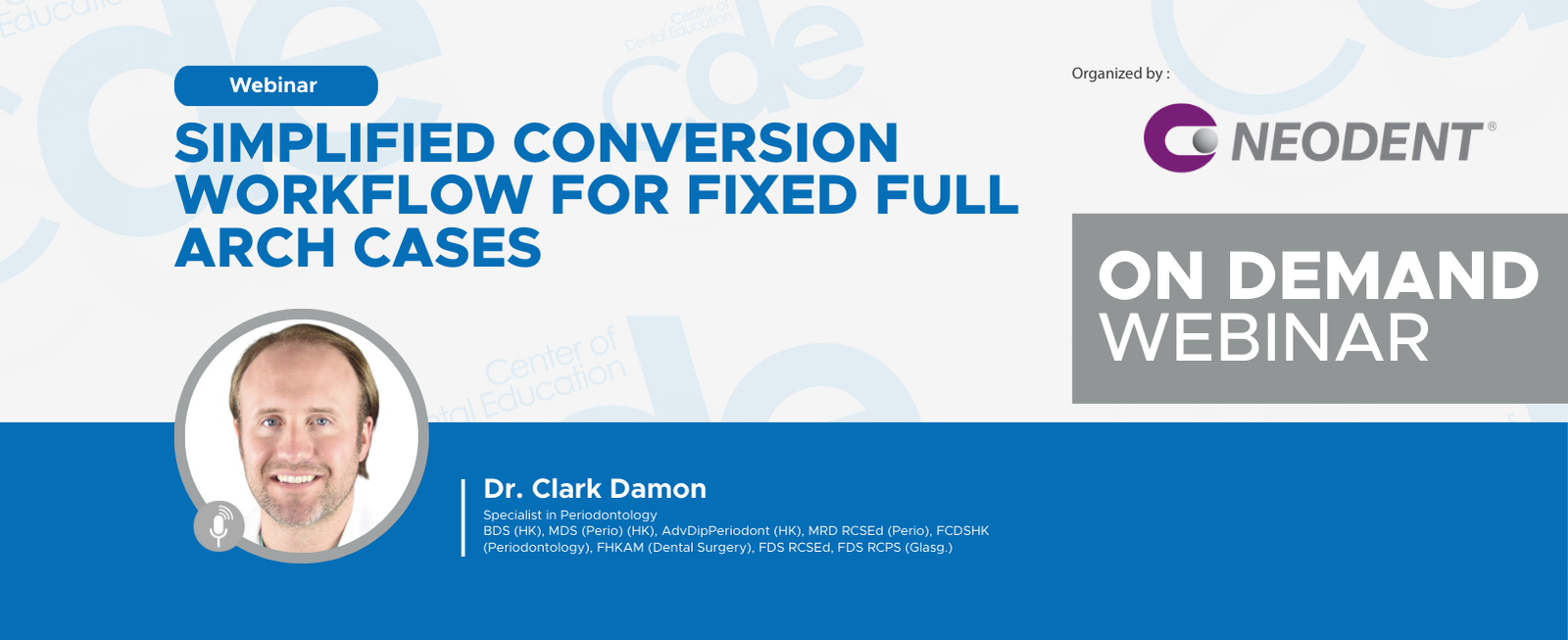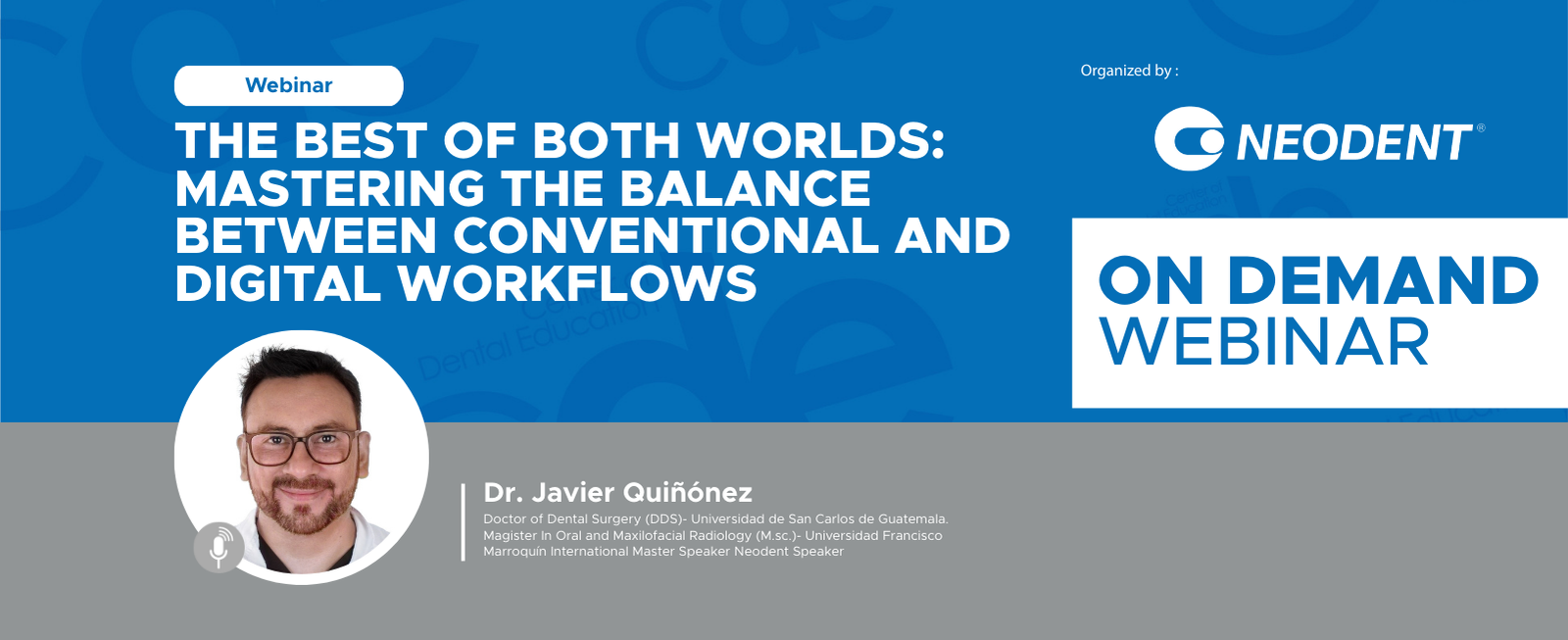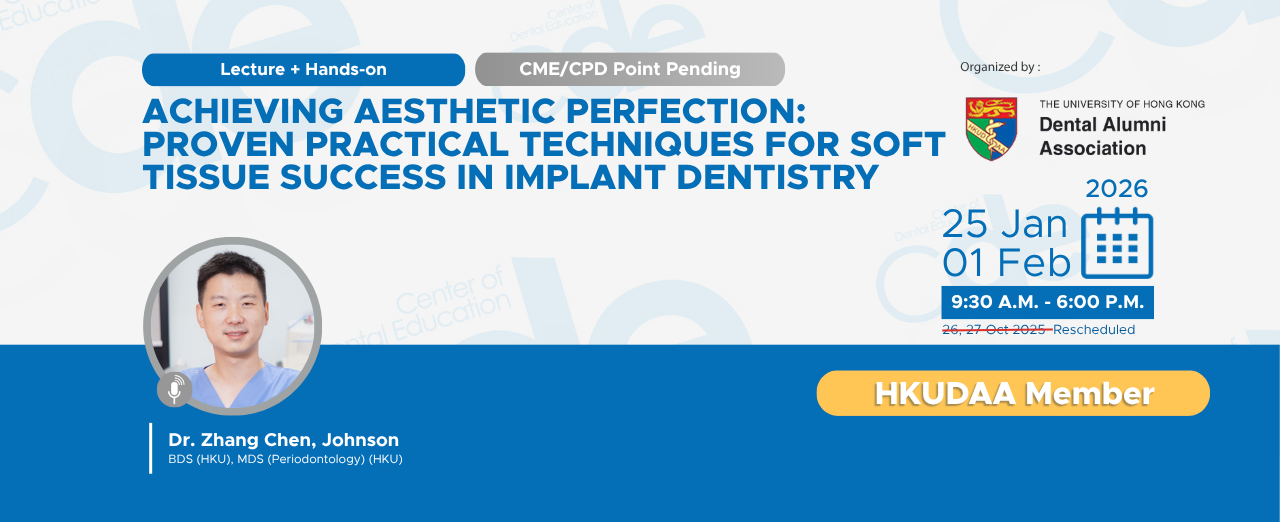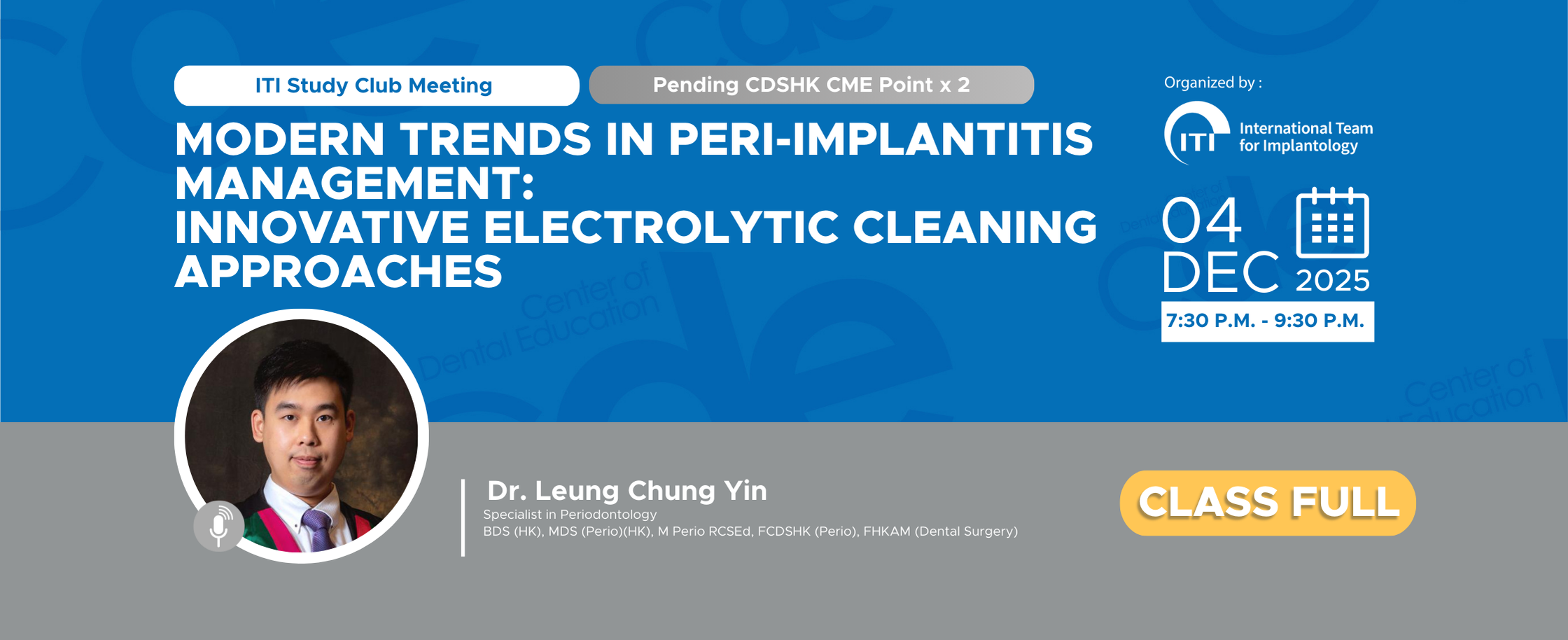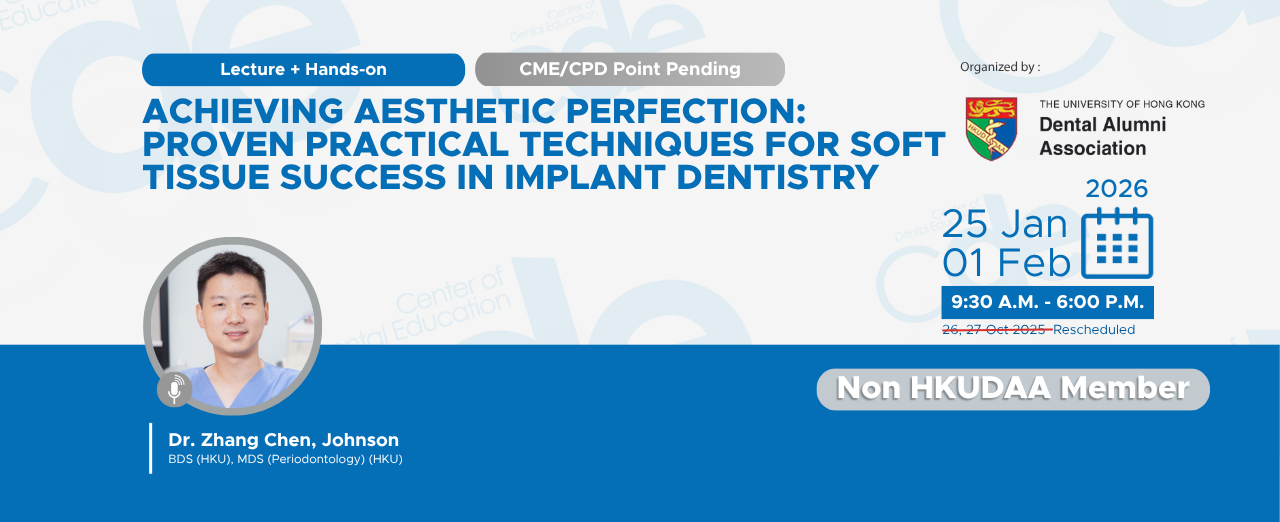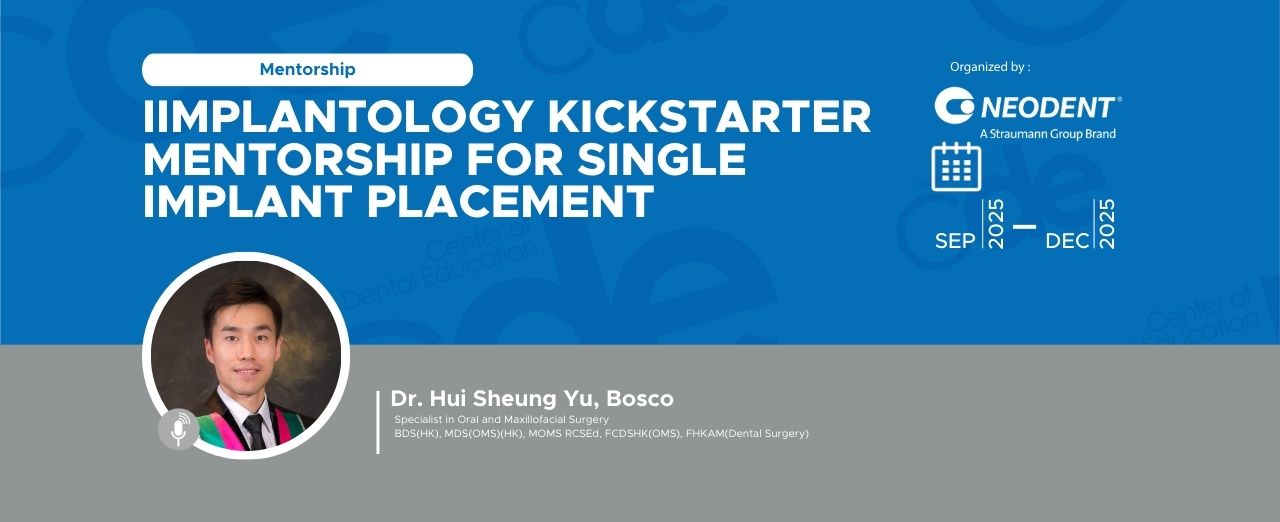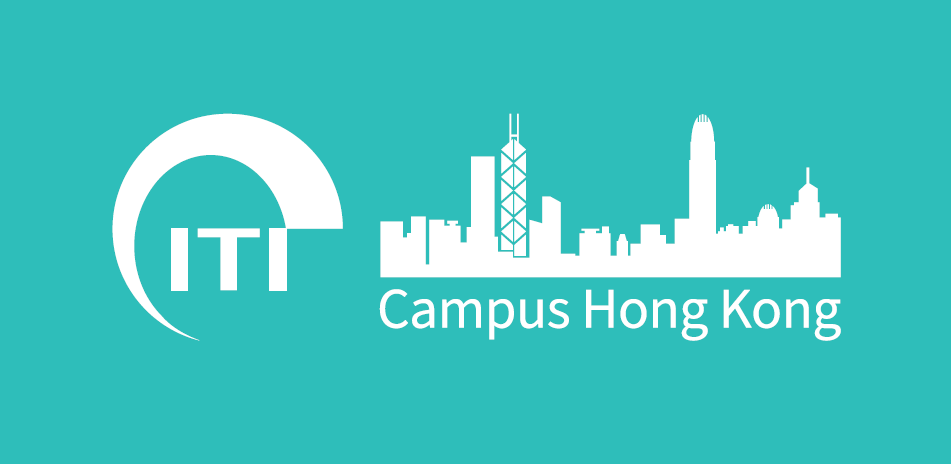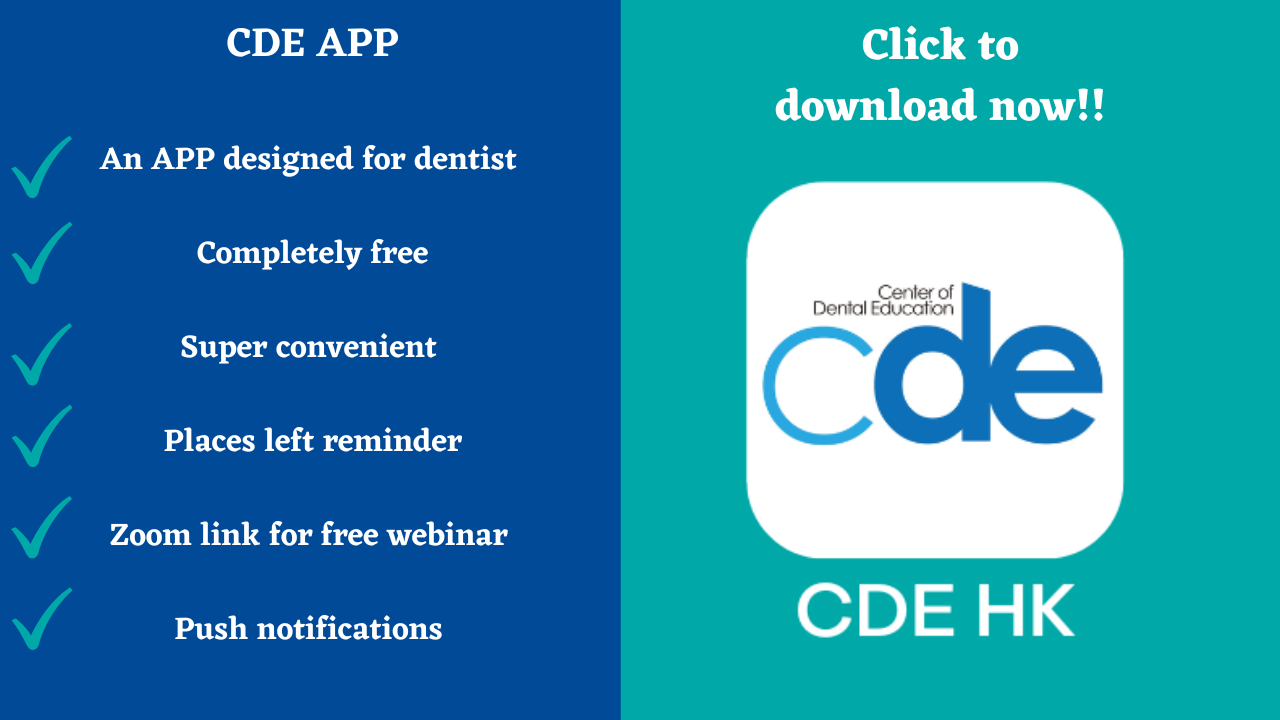HKIDEAS ITI Day
06 Oct 2021
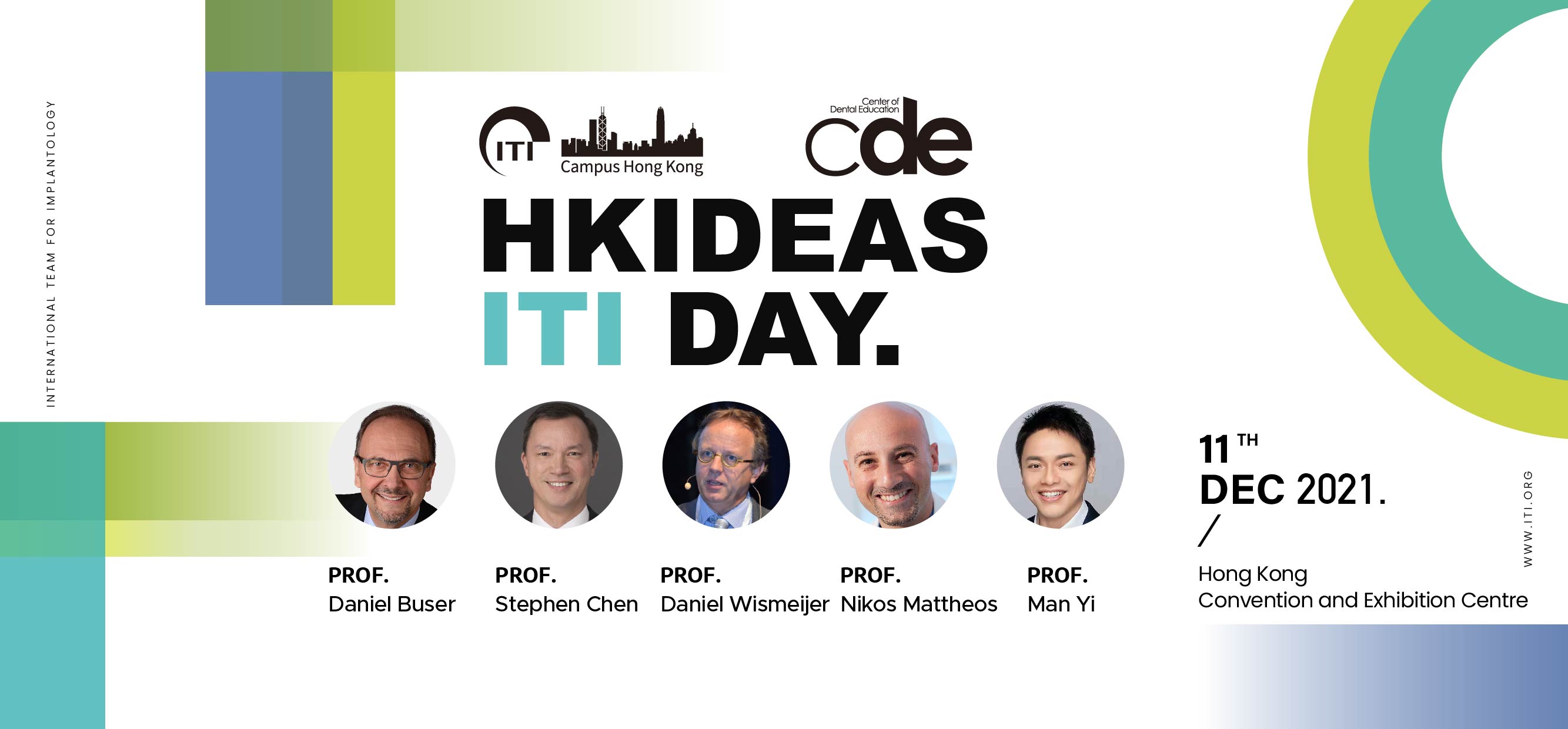
Join HKIDEAS and enjoy a full day with the best from global Implant Dentistry!
ITI campus Hong Kong in partnership with HKDA will bring you a full day with the latest developments in Implant Dentistry, by a global dream-team of speakers!
With more than 18,000 members and fellows, the International Team for Implantology is the leading global scientific and professional society in Implant Dentistry, with focus on patient care, education and research. Join us of a full day introducing the practice of the future in implant dentistry!
DATE: 11 December 2021 (Sat)
VENUE: Hall 3F, 3/F, HKCEC
09:00 – 10:30, 11:15 – 12:45
Post-extraction implant placement: When immediate, when early and when late?
Speaker - Prof. Stephen Chen (Australia)
When a dental implant is indicated to replace a tooth that needs to be extracted, the clinician has the opportunity to control the timing of extraction and subsequent implant placement. Each time point for implant placement after extraction has its advantages and disadvantages. In this 2-part seminar, an update on current concepts of post-extraction healing will be given. Following this, the new classification for implant placement and loading time will be presented. The case selection criteria for immediate, early and late placement for optimum outcomes will be discussed, and supported by clinical cases and videos. Following this seminar, attendants should be able to :
- Describe the concepts of post-extraction healing and the accompanying dimensional alterations of the alveolar ridge
- Classify implant placement and loading time
- Outline the advantages and disadvantages of immediate, early and late placement
- List the case selection criteria for immediate, early and late placement
Prof. Stephen Chen
Prof. Stephen T. Chen is a specialist periodontist in private practice in Melbourne, Australia. He holds the position of Clinical Associate Professor at the School of Dentistry at the University of Melbourne. He graduated BDS (Malaya) in 1983, MDSc (Melbourne) in 1987, FRACDS in 1988 and PhD in 2008. Dr Chen’s scientific interests are in the field of tissue regeneration and post-extraction implant outcomes. He is immediate past-president of the International Team for Implantology and has served in leadership positions in the Australian and New Zealand Academy of Periodontists and Australasian Osseointegration Society. He is the author of numerous scientific publications world and an internationally acclaimed speaker in Implant Dentistry.
14:15 – 15:45
The rendered reality of digital implant dentistry. A fake reality?
Speaker - Prof. Daniel Wismeier (Netherlands)
To render is to cause someone or something to be in a particular state. In a digital reality we define rendering as the process of generating a photorealistic or non-photorealistic image from a 2D or 3D model by means of a computer program. The question arises if the rendered reality is the result of an artist's impression of a scene.
To understand what digital dentistry actually is we need to get a grip on what digitisation, digitalisation, CAD CAM actually is and how we incorporate these digital technologies into the Dental Digital Technology or the Dental Digital Reality. How do we combine 2 and 3 dimensional data and which digital languages are involved? When carrying out the rendering processes and quantizing the information what does this do with the quality of the reality we are creating.
How safely can we work in the reality we have rendered? What errors are caused by the software that we use, and can we compensate for that?
Prof. Daniel Wismeijer
Prof. Wismeijer studied dentistry at the University of Nijmegen Dental
School from 1979-1984. After graduating he joined the Department of Oral
Function and worked in de section of special dental care and Maxillofacial
Prosthodontics. He received his Ph.D. in 1996 on the subject of overdentures on
dental implants; “The Breda Implant Overdenture Study”. In that year he left
Academia. From 1985 till 2006 he worked at the Amphia teaching Hospital in
Breda in the department of Oral Surgery and Maxillofacial Prosthodontics.In 1985 he started a general dental practice which since 1990 is a referral
practice for Oral Implantology. In 2006 he accepted the position of Professor
of Oral Implantology and Prosthetic Dentistry at ACTA Amsterdam which he
combined with his referral practice. He has served in many academic leadership
positions including the head of the section of Oral Implantology and Prosthetic
Dentistry at ACTA. In January 0f 2020 he left ACTA.
He is the author of numerous high impact international publications and
recipient of multiple prestigious research grants. His research is focused on
“CAD/CAM treatment optimization”, “Digital Dentistry, treatment evaluation and
workflow”,” implant surface and bone substitute optimization”
“peri-implantitis” as well as “ the evaluation of different implant-based
treatment modalities”. He has been president of the Dutch Prosthodontic
Association and the Dutch Association for Gnathology. He is examiner of the
Royal College of Surgeons of Edinburgh, has been an ITI fellow since 1993 and
served in many leadership positions including, member of the ITI research committee,
Chair of the ITI education committee and as such member of the ITI Board of
Directors.
Computer Assisted Implant Surgery: Key Technology or Hype?
Speaker - Prof. Nikos Mattheos (Hong Kong)
Computer Assisted Implant Surgery (CAIS) is rapidly becoming a golden standard for precise and accurate placement of dental implants. Two main directions of CAIS have emerged and are currently in use, namely the static approach with the use of milled or 3D printed guides and the dynamic navigation with a real-time tracking of the surgical instruments. The respective technologies that have evolved very quickly and have matured into clinical practice with excellent documented results. Allowing the implant to be placed in the planned prosthetic position, CAIS empowers advanced loading protocols within immediacy, with the use of prefabricated immediate provisional restorations or even immediate loading. Furthermore, as a core technology it unlocks many future directions such as robotic implant placement. CAIS technology is rapidly expanding to other areas of oral surgery such as sinus augmentation or periodontal surgery.
Despite the enthusiastic introduction of such technologies however, the wider implementation in the mainstream clinical practice is not without challenges. Apart from the initial high investment and significant learning curve, factors such as technical limitations, cost/effectiveness, scope of clinical procedures and patient characteristics might limit the anticipated benefits of CAIS for many clinicians. Consequently, many colleagues currently wonder if CAIS is a tool which can benefit mainstream implant practice or rather a device more suitable for complex procedures and specialised practice. In addition, it turns out that experience with conventional implant dentistry is an essential prerequisite for successful application of CAIS, which might question the potential of CAIS as a device for novice surgeons. In this presentation we will discuss the main principles of CAIS, as well as the main devices and protocols that are currently available. Through a series of recently conducted clinical trials in Chulalongkorn University, we will identify the potential and limitations of each technique, discuss patient selection, most common risks, errors and misperceptions and also investigate the patients' experience and related outcomes. Finally, we will aim to reach some meaningful clinically relevant conclusions to help determine the potential of CAIS in their practice.
Prof. Nikos Mattheos
Prof. Nikos Mattheos graduated from the Dental Faculty of the University of Athens. He completed his Masters degree in Health Informatics and his PhD degree in the University of Malmö, Sweden, where he also completed specialist training in Periodontology. He then attended a 3 year-residency in Fixed Prosthodontics and Implant Dentistry in the University of Bern, Switzerland under Professor N.P. Lang. He is accredited Periodontist by the European Federation of Periodontology and has worked in university clinics and hospitals among others in Greece, Sweden, Switzerland, Australia, Hong Kong and Thailand.
He is currently Visiting Professor of Implant Dentistry in the department of OMFS in the Faculty of Dentistry , Chulalongkorn University, while he is also holding academic affiliations with Karolinska Institute and Malmö University in Sweden. His research is disseminated through more than 120 publications in international peer reviewed journals, and he has received numerous awards, including the International Association of Dental Research researcher’s award in 2003 and 2013 and the Andre Schroeder Award in 2014 and 2021. He is also a world leading expert in dental education, in particular with electronic media and has designed and operated many international courses for implant dentistry.
He is Associate Editor of the International Journal of Prosthodontics and member of the editorial boards of several peer-reviewed journals within Implant Dentistry such as Clinical Oral Implants Research. He is ITI Fellow since 2008 and member of the Board of Directors of ITI. He maintains private practice in Hong Kong focused in Oral Rehabilitation and Implant Dentistry
16:30 – 18:00
The value of hybrid design implants
Speaker - Prof. Daniel Buser (Switzerland)
The term Hybrid Design Implant (HDI) was first defined the by Dennis Tarnow in 1993. The term stands for an implant with a micro-rough implant surface in the endosseous portion to promote a faster and better osseointegration of the implant during healing and during function, and a smooth, machined surface in the neck/collar region for the trans-crestal area with contact to the peri-implant sulcus. The most prominent HDI is the iconic Tissue Level (TL) Implant, which was first inserted in patients in 1986 (Buser et al. 1988). Clinical long-term studies have clearly documented the least risk for the development of peri-implant mucositis and peri-implantitis (Derks et al. 2016a; Derks et al. 2016b), when compared with implants with a micro-rough surface all the way up to the implant neck. The long-term documentation at the University of Bern confirmed the low risk of roughly 3% for the development of peri-implantitis with TL implants in a large 10-year study with 500+ TL implants (Buser et al. 2012). This lecture will present all relevant aspects of HDI and what surgical factors are essential to achieve successful outcomes with good long-term stability. Special emphasis will be given to new implant designs based on the HDI concept with the TLX implant, later with the TLT implant.
Prof. Daniel Buser
Prof. Daniel Buser is one of the most experienced international implant surgeons with 35 years of surgical experience. He widely lectures at
national and international conferences, and CE courses to share his knowledge. He has been Professor and Chairman at the Department of Oral Surgery at the University of Bern/Switzerland (2000-2019). Among others, he spent several sabbaticals, twice at Harvard University (1989-91 and 2016), at Baylor College of Dentistry in Dallas (1995), and at the University of Melbourne (2007/08). He served as President of various academic associations including the EAO (1996/97), the Swiss Society of Implantology (SGI, 2001-03), and the ITI (2009-13). He received several scientific awards incl. the André Schroeder Research Prize (1995), the Honorary Membership Award by the AAP (1997), the Brånemark Osseointegration Award by the AO (2013), the Jerome and Dorothy Schweitzer Research Award by GNYAP (2015), the ITI Honorary Fellowship by the ITI (2017), and the Eskow Implant Dentistry Award by the New York University (2018). With his team, he has authored and co-authored more than 400 publications and book chapters on translational research in the field of implant dentistry. Several are landmark publications with high citation rates. In addition, published as Editor the famous GBR Book by Quintessence, which will be published in the 3rd Edition in summer 2021. He is currently engaged with research and exchange of knowledge with worldwide audiences and events.
Suturing Protocols and Error Prevention in Implant Surgery.
Speaker - Prof. Man Yi (China)
Proper suturing is one of the essential steps to secure proper healing outcomes in implant surgery. Selection of proper suturing techniques and correct applications can successfully close the wound, reduce tension and promote healing. Nevertheless, several challenges exist and often errors can occur from both novice and experienced surgeons. This presentation will focus on different suturing protocols and discuss different techniques as well as the most common challenges and errors. Through actual clinical cases and surgical videos we will discuss the selection and application of ideal suturing protocols and the prevention of the most common errors in simple or complex implant surgeries.
Prof. Man Yi
Professor Man Yi, , is the head of Oral Implantology Department, Director of Education and Research Department of Oral Implantology Department, and a postgraduate tutor at West China School of Stomatology, Sichuan University. He is a Standing Committee of the Committee of Implantology of Chinese Stomatological Association, Chairman of Chinese Society of Digital Dental Industry, President (China) of The International Congress of Oral Implantologists (ICOI), reserve candidate for Academic and Technical Leader of Sichuan Province Health and Family Planning Commission, Chairman of Special Committee of Sichuan Province Oral Implantology, Associate Editor of Clinical Implant Dentistry Related Research (Chinese Edition), Implant Dentistry Editorial reviewer board, International College of Dentists (ICD Fellow), International Team for Implantology (Fellow), The International Congress of Oral Implantologists (ICOI) diplomate, member of Sichuan Stomatological Association (SCSA), and Standing Committee of Stomatological Equipment Committee of Sichuan Stomatological Association.
He was mentored by professor Gong Ping and received Ph.D of Stomatology at West China School of Stomatology in 2007. In 2010, he was awarded “ITI Scholar” by International Team for Implantology. During 2010-2012, he worked in Tufts University School of Dental Medicine (Boston,USA) as a clinical instructor. He was also a research scholar in Massachusetts General Hospital of Harvard University (Massachusetts, USA) during 2011-2012. Through the summary of his own clinical practice, he has modified and proposed several modified implantology surgical techniques as well as prosthodontic techniques, and these techniques have been published in over 40 papers on international implantology, surgical, and prosthodontic journals.
